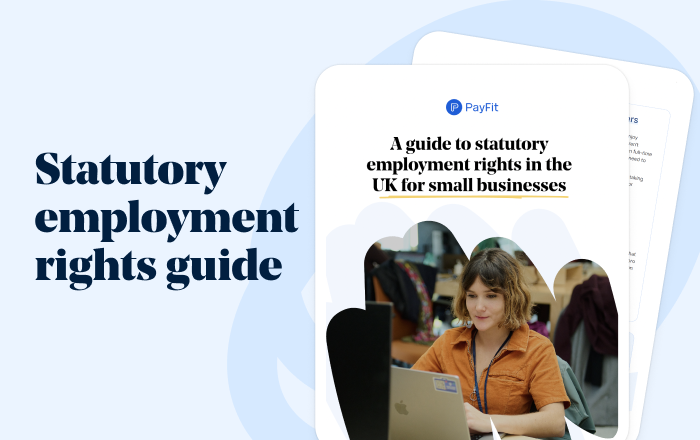✨ Health insurance, now in PayFit - learn more
💷 All the rates & thresholds you need to know for 25/26...right here
✨ The Payroll Journey: Start, Scale & Succeed Globally - learn more
✨ Health insurance, now in PayFit - learn more
💷 All the rates & thresholds you need to know for 25/26...right here
✨ The Payroll Journey: Start, Scale & Succeed Globally - learn more

Here’s the crux of what you need to know about working time regulations:
Managing a growing team is complex. As a business leader, HR manager, or finance professional, you have to balance growth with operations. Amidst this, employment law can be a literal minefield. One of the most critical pieces of legislation every UK employer must master is the body of law on working time.
This legislation is not just red tape. It’s a fundamental UK law protecting employee health, well-being, and safety. It governs everything from maximum weekly workloads and rest breaks through to paid annual leave. For a growing business, getting this wrong can lead to employment tribunals, fines, and a damaged reputation.
This article breaks down what you need to know. We will cover the core principles, recent changes, and your responsibilities for keeping accurate documentation. Understanding this is essential for compliance, and for building a sustainable, healthy work environment for your people.
The primary working time law is that enshrined in the Working Time Regulations 1998. Its purpose is to protect workers’ well-being and safety by placing strict limits on working hours, alongside other UK statutory employment rights.
Crucially, it applies to all workers, not just ‘employees’. This wider definition can include casual staff, agency staff, and some freelancers, if they are employed under a contract to perform work personally.
The most well-known rule is that an individual aged 18 or over cannot work more than an average of 48 hours per week. This 48-hour limit is an average, typically calculated over a reference period of 17 weeks, not a cap on every single week.
This limit can also be increased by paying overtime, especially if the individual has opted out of the Working Time Directive as part of their employment contract.
Your staff can choose to work more than 48 hours per week by signing a simple opt-out form. This must be a completely voluntary decision. You, as the employer, cannot force an individual to sign this document, or penalise them in any way for refusing to do so.
The agreement must be in writing, and the employee has the right to change their mind at any time with adequate notice given. You must make sure you keep a copy of all the related documentation in your files.
The guidelines are much stricter for younger staff (those over school-leaving age, 16, yet under 18). A person in this age group cannot work more than 8 hours per day or 40 hours per week. These are firm limits, not averages. Critically, such young people are not allowed to opt out of the 48-hour limit.
The legislation mandates specific breaks to protect well-being. These fall into the three main categories, of in-work rest, daily rest, and weekly rest break.
Any individual who works a day longer than 6 hours is entitled to an uninterrupted break of 20 minutes. This should be taken during the work period, and not at the start or end.
Every worker also has the right to 11 consecutive hours of downtime in every 24-hour period. This is called ‘daily rest’.
In addition, staff have a right to a break each week. This should be either an uninterrupted 24 hours of rest in each 7-day period, or uninterrupted 48 hours in each 14-day span.

UK statutory employment rights guide
This is often the most complex area for employers, especially when it comes to managing pay.
All workers have a statutory holiday entitlement to 5.6 weeks of paid annual leave per year. This is equivalent to 28 days for a full-time worker (5.6 x 5 days), which can include bank holidays. Holiday entitlement for part-time staff is the same but is based on a pro-rata calculation.
Calculating holiday entitlement and pay for casual staff and part-year workers can be a major headache. However, the government has introduced changes. For leave years starting on or after 1st April 2024, employers can once again use the 12.07% calculation method for irregular-hours workers and part-year workers.
This allows you to calculate holiday entitlement as 12.07% of the hours worked in a pay period. In any case, managing holiday pay correctly is still complex. Good payroll software such as PayFit’s payroll suite simplifies leave management and pay for all your workers.
The legislation has special provisions for night work, due to the associated increased well-being and safety risks. Night time is usually defined as starting at 11 pm and ending at 6 am. A night worker is then someone who regularly works at least 3 hours during this time frame.
Night staff must not work more than an average of 8 hours in any 24-hour period. You must also offer a free health assessment to any worker before they start night work. This is a step that complements wider initiatives to support staff, such as offering an employee assistance programme.
You cannot prove compliance without documentation. The law requires employers to keep ‘adequate records’ to show that the limits on weekly working time and night work are being met.
This means you must track the shifts worked by your staff, and keep a list of all individuals who have signed an opt-out agreement. This documentation must be kept for at least two years following the date they were created, and be ready to print on demand.
Furthermore, this it is not just a legal formality. It is a core part of being prepared for any internal or external payroll audit. For an overview, the ACAS website provides clear guidance on these documentary requirements.
Failure to comply with your obligations is a serious matter, and is often treated as a health and safety violation. This can lead to employment tribunal claims from workers, or to investigation and prosecution by the Health and Safety Executive (HSE).
For a growing business, manual tracking is not scalable, and is unavoidably prone to error. Modern payroll and HR software automates all of the necessary processes. It can track work and project hours, manage leaves and absences, and automatically calculate correct overtime and holiday pay, even for your staff on non-standard contracts.
It provides a clear audit trail and frees up your HR and finance resources from complex administration by integrating leave, pay, and employee data into a single integrated HR software system.

Working time is any period during which the worker is working, at the employer’s disposal, and carrying out their agreed duties. This includes training required by the employer, work-related travel (but not normal commuting), and time spent ‘on-call’ at a workplace. Time spent on-call at home is generally not considered working time, but only if the individual is completely free to use their on-call time as they wish. This is a bit of a grey area, because if you expect them to be at a desk and operative within 10 minutes, then it probably means they can’t go to the gym. So, the on-call time, in this case, would actually count. If that expectation, on the other hand, were extended to an hour or two, or the following morning, then it wouldn’t count.
Yes, an employer can tell a worker when to take their leave. To do this, you must give them adequate notice of at least double the length of the holiday you want them to take. For example, you must give two weeks’ notice for one week of leave.
The April 2024 changes in payroll legislation primarily affect irregular hours and part-year workers. They simplify how you calculate their holiday entitlement and pay, reintroducing ‘the 12.07% method’. This strictly applies only to these categories of workers. Note that the category of irregular hours workers includes those on zero-hours contracts, casual workers, and ‘bank staff’, that is, those on a list of pre-approved, casual staff, ready to be called upon to fill temporary gaps.
An ‘employee’ is a type of worker who has an employment contract. The term ‘worker’ is broader, and not only covers employees, but also those on more casual contracts who are not self-employed. The working time regulations apply to almost all workers, not just employees, which is why this distinction is vital. This includes misclassified ‘self-employed freelancers’, who are contracted to perform work personally, and are not truly independent of the company they are performing it for. It excludes the genuinely self-employed and true freelancers, who perform, control and regulate their own work and working time independently.
The best approach is to use a centralised HR software system. This allows you to store digital copies of opt-out agreements, track all leave requests, and maintain accurate records of hours worked. PayFit’s HR features are designed to handle this by centralising all your worker data, including documents and leave balances, via a securely accessed single platform.

A new flexible working law came into effect in 2024. Employees have more say over how & when they work. Understand what it means for you as an employer.

Our comprehensive guide on the statutory notice period for UK businesses. Understand legal minimums, contractual rights, PILON, and how to stay compliant.

Explore the impact of AI in HR for businesses. Learn about tools, benefits, risks & best practices in using artificial intelligence for your HR processes.

The Alabaster ruling dictates that SMP must take into account any pay rises for the individual within a certain time period. Find out more here.

Click for an overview of UK equal wage laws, guidance on how to address equal pay issues, and where to find further advice and information.

Here, we provide a clear explanation of PENP, how it's calculated, and its tax implications, so you can tackle this tricky aspect of UK employment law.